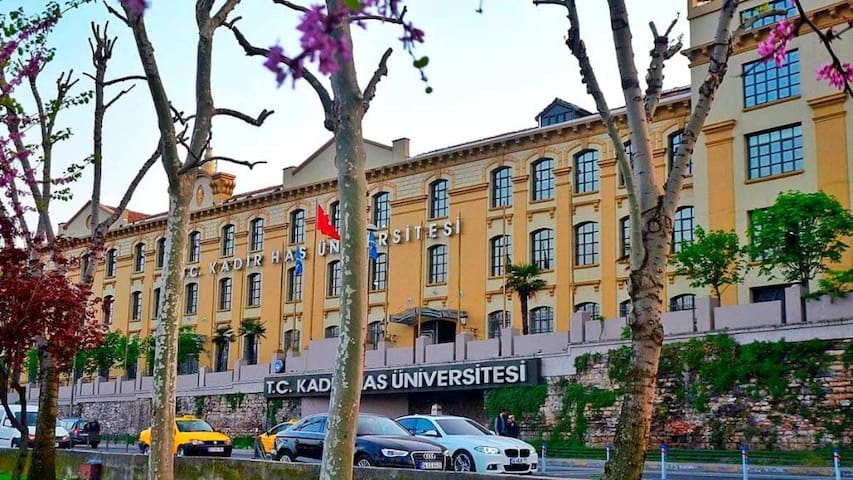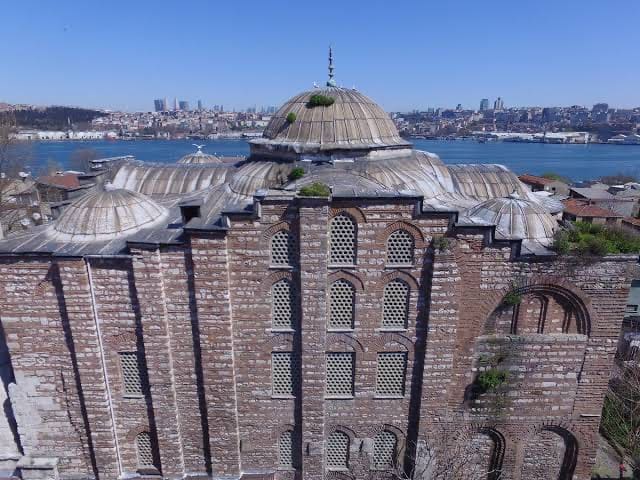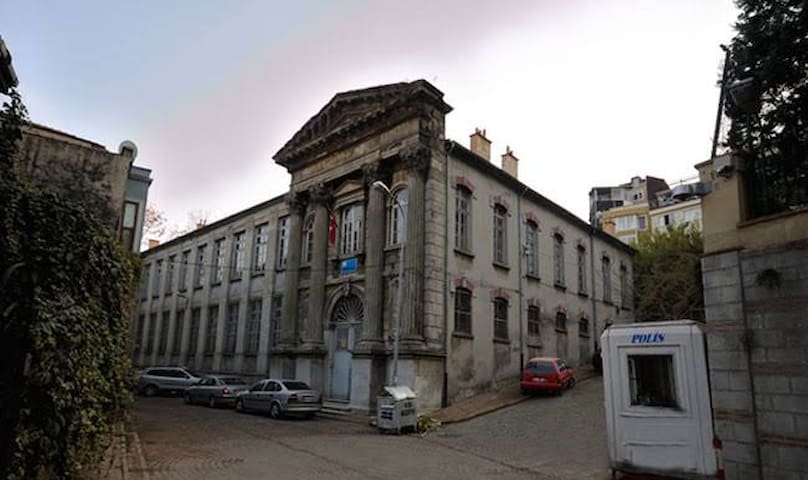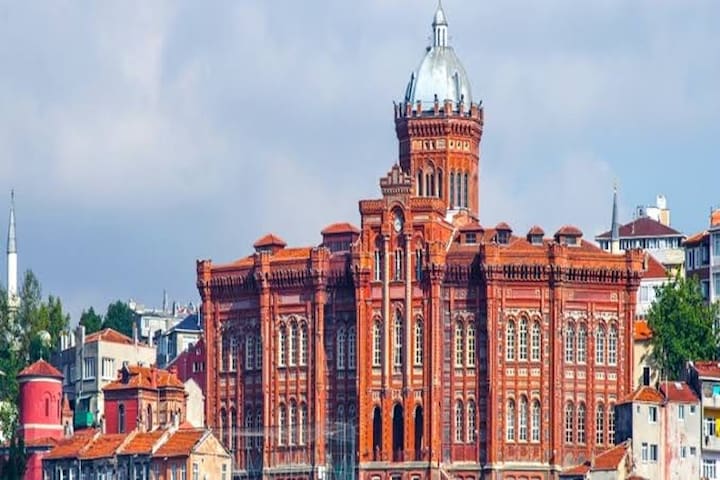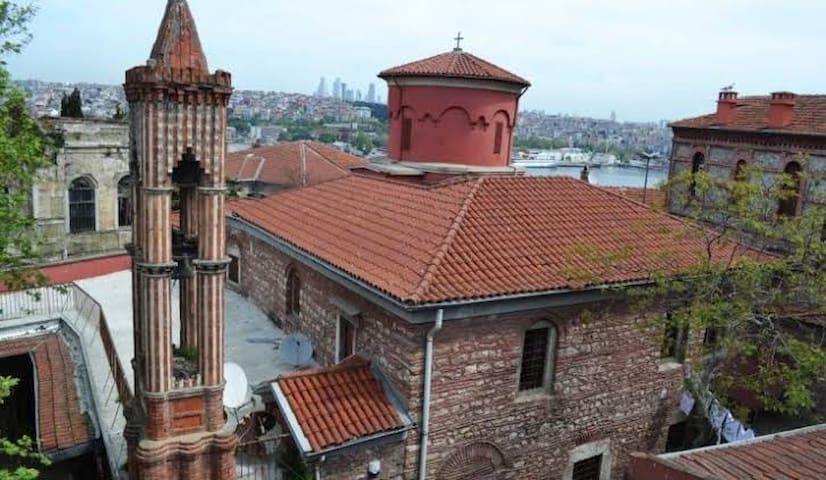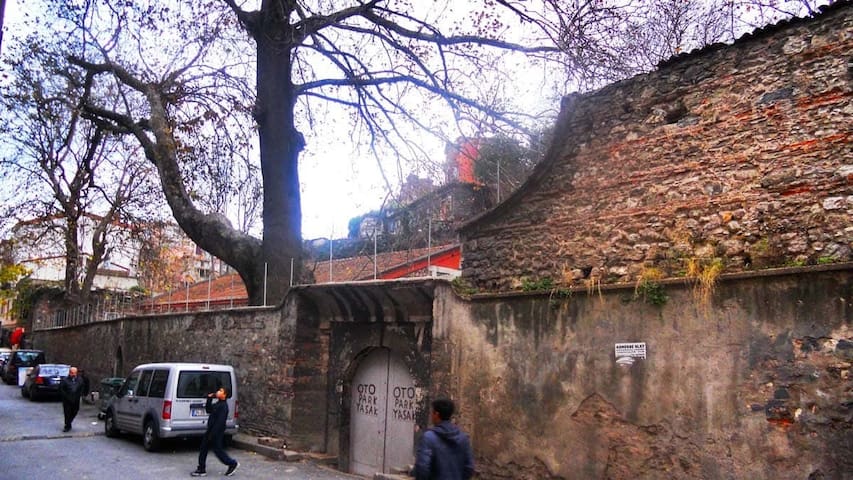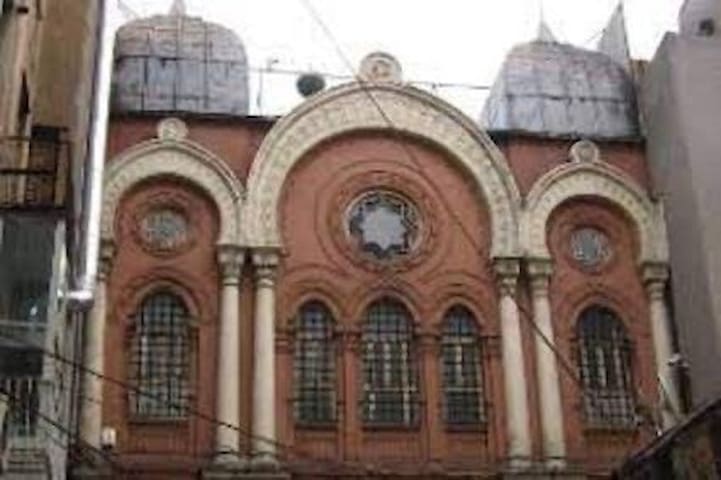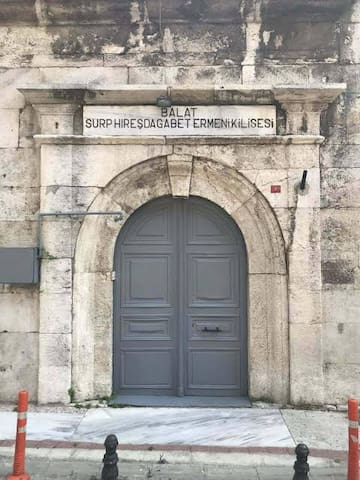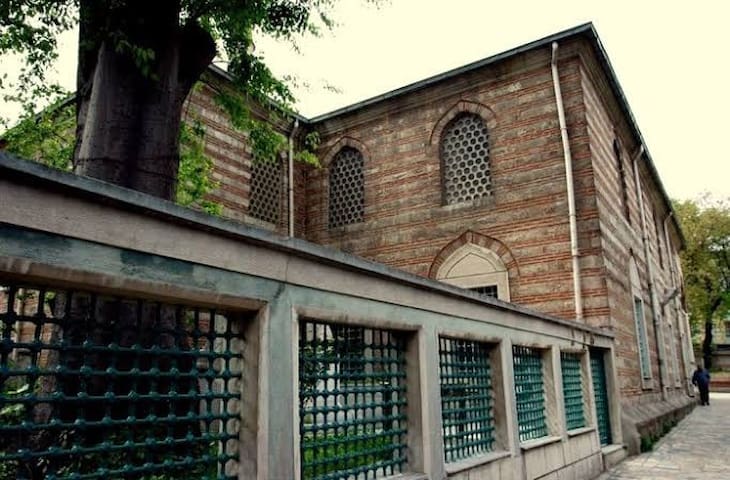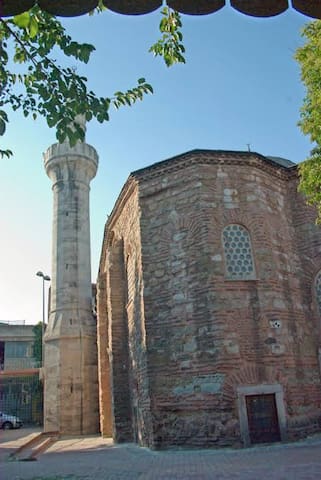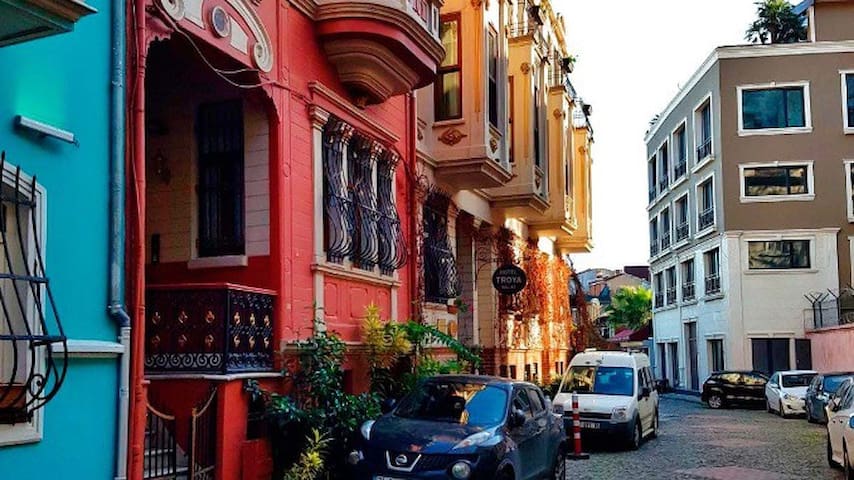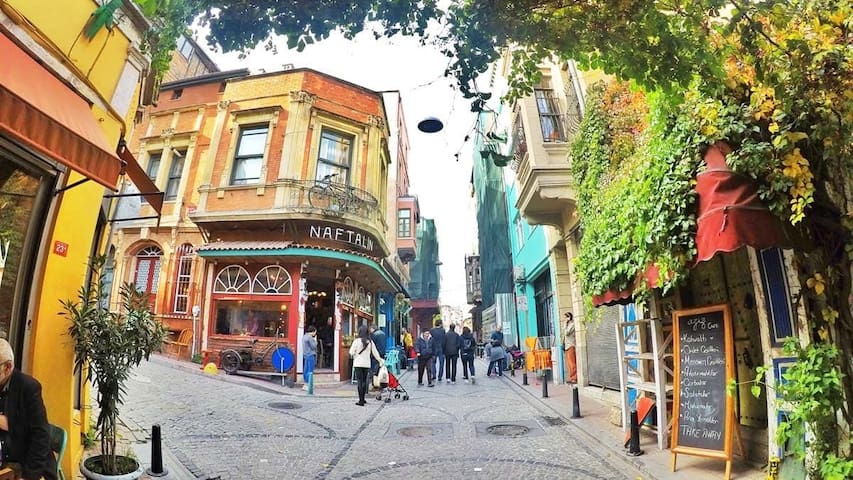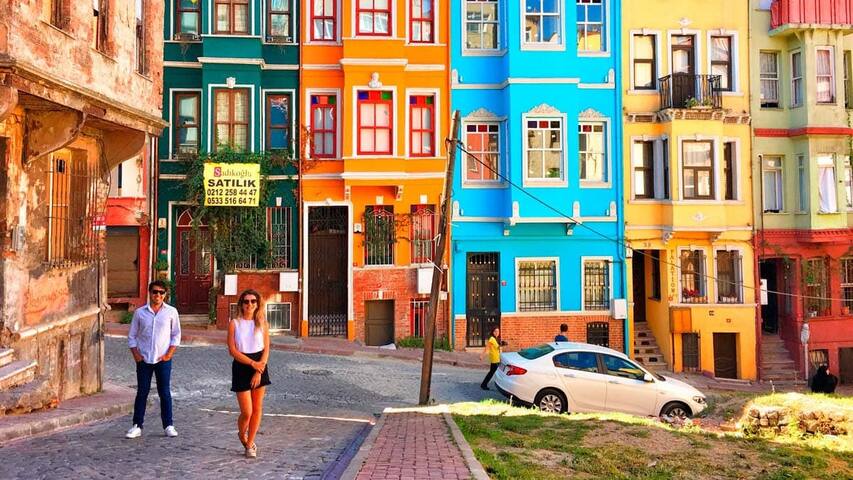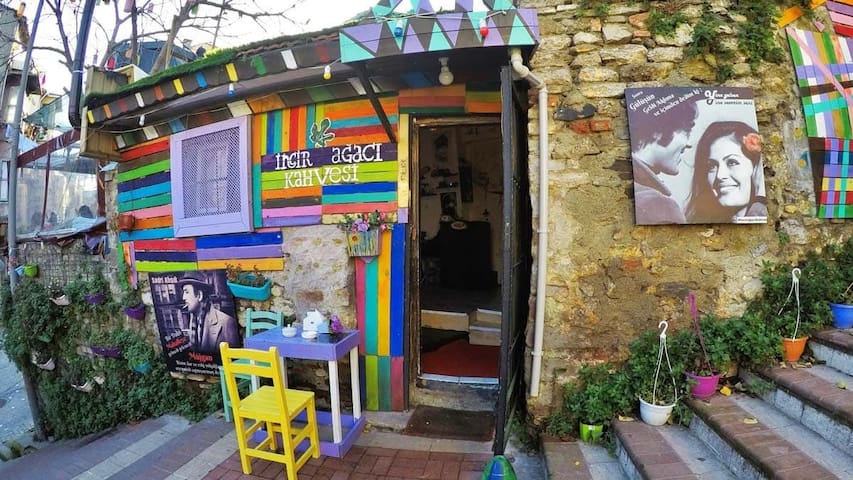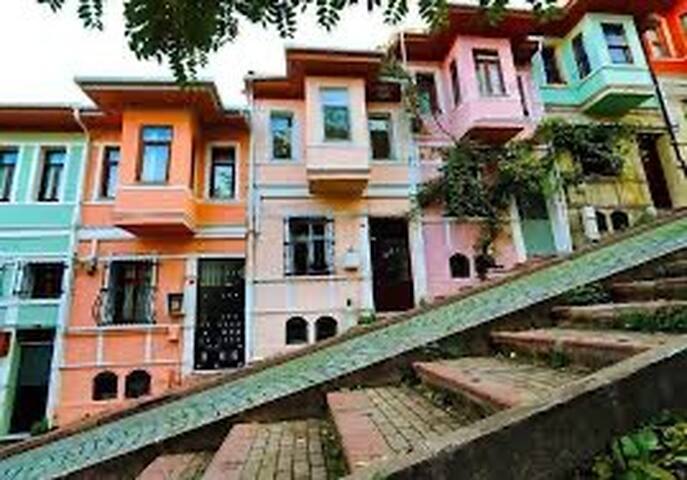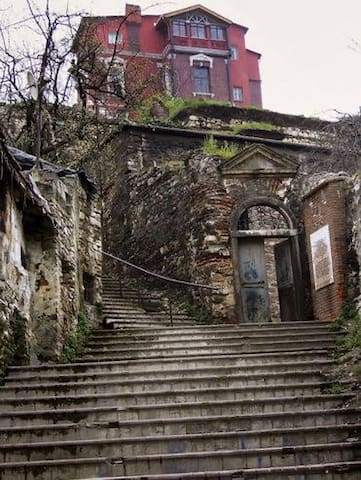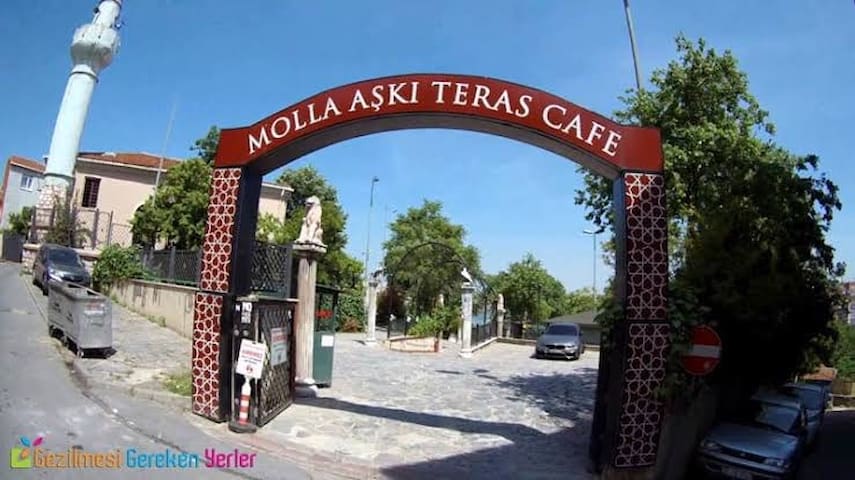Gezilecek yerler
Balat
Cibali Tobacco Factory / Kadir Has University
The building, which is today the building of Kadir Has University, was built during the reign of Abdulhamid II in 1884 as the Reji Company building, which was affiliated to the Düyunu Umumiye and held the tobacco monopoly. In 1924, when all privileges were abolished, it was transferred to the Government of the Republic. The design of the building, which is one of the first and most important structures of our industrial history, is by the famous architect of the period, Levantine origin Alexandre Vallaury, and the architecture is by Housef Aznavur. It is important because it is one of the first examples in our country of the modern factory made with Western-style materials such as iron, casting, glass and brick.
Kadir Has University
Kadir Has CaddesiCibali Tobacco Factory / Kadir Has University
The building, which is today the building of Kadir Has University, was built during the reign of Abdulhamid II in 1884 as the Reji Company building, which was affiliated to the Düyunu Umumiye and held the tobacco monopoly. In 1924, when all privileges were abolished, it was transferred to the Government of the Republic. The design of the building, which is one of the first and most important structures of our industrial history, is by the famous architect of the period, Levantine origin Alexandre Vallaury, and the architecture is by Housef Aznavur. It is important because it is one of the first examples in our country of the modern factory made with Western-style materials such as iron, casting, glass and brick.
One of the exhibition venues of the Istanbul Biennial, now used as an exhibition space, the largest Turkish bath in Istanbul, Küçük Mustafa Pasha Hamam, was executed in 1483 for the vizier of Sultan Beyazıt II, for taking the side of Cem Sultan in the Cem Sultan incident. It was built by Küçük Mustafa Pasha. There is a marble pool in the middle of the bath.
Tarihi Küçük Mustafa Paşa Hamamı
30a Müstantik CaddesiOne of the exhibition venues of the Istanbul Biennial, now used as an exhibition space, the largest Turkish bath in Istanbul, Küçük Mustafa Pasha Hamam, was executed in 1483 for the vizier of Sultan Beyazıt II, for taking the side of Cem Sultan in the Cem Sultan incident. It was built by Küçük Mustafa Pasha. There is a marble pool in the middle of the bath.
Hagia Theodosia Church, built in the 8th century by the Byzantine Emperor Leon III. A woman named Teodosia was executed by being subjected to various tortures as the leader of those who protested against the breaking of icons during the Icon Breaking Period (726-842). The Byzantines declared Teodosia, who was killed for the sake of religion, a saint and built this church in her name in the 9th century. The Ottomans, who conquered Istanbul in 1453, were so impressed when they entered the church on the feast day when the church was fully decorated with roses, and saw it covered with roses, that they left without touching both the church and the people who worshiped it. The church, which was later converted into a mosque, was called the Rose Mosque based on this rumor.
Gul Camii
Hagia Theodosia Church, built in the 8th century by the Byzantine Emperor Leon III. A woman named Teodosia was executed by being subjected to various tortures as the leader of those who protested against the breaking of icons during the Icon Breaking Period (726-842). The Byzantines declared Teodosia, who was killed for the sake of religion, a saint and built this church in her name in the 9th century. The Ottomans, who conquered Istanbul in 1453, were so impressed when they entered the church on the feast day when the church was fully decorated with roses, and saw it covered with roses, that they left without touching both the church and the people who worshiped it. The church, which was later converted into a mosque, was called the Rose Mosque based on this rumor.
Odessa City Mayor Grigoris Maraslis wanted Fener to build a school that will be named after him. The school, which is famous for its Neo-Classical style, Corinthian column, triangular pediment, reminiscent of the entrance of ancient Greek temples, started education in 1901. Although it has very few students, it still continues to provide education at the primary school level.
Özel Maraşlı Rum İöo
32 Doktor Sadık Ahmet CaddesiOdessa City Mayor Grigoris Maraslis wanted Fener to build a school that will be named after him. The school, which is famous for its Neo-Classical style, Corinthian column, triangular pediment, reminiscent of the entrance of ancient Greek temples, started education in 1901. Although it has very few students, it still continues to provide education at the primary school level.
The transformation of this church into a patriarchate took place during the reign of Patriarch Mattihaios II, who served between 1595 and 1602. There used to be a women's monastery on the site of the building, which is now the patriarchate. It was built in 1836 with its current plan. It was renovated in 1941 when it suffered a great fire.
The Patriarchate has 3 wooden main doors at the entrance, but the one in the middle has been locked since 1821 and has never been opened. Because the middle door is the door where Patriarch Gregory was hung with a rope on the grounds that he supported the Greek uprising that broke out at that time on Easter Day on April 10, 1821. The body of the patriarch remained on the rope for 3 days and a label was attached to it that he was punished for betraying the state. Later, a rope was tied to his feet and he was dragged to the shore of the Golden Horn and thrown into the sea.
At the entrance of the church, there is the patriarch crown, which symbolizes the patriarchate. When you enter through the door, there is a wishing section where candles are lit. You can donate as much as you want to the church and light a wishing candle. The Patriarch's Throne made of walnut wood, decorated with vegetal motifs of ivory and mother-of-pearl, dated to the 5th century, gold-plated panel, Hz. The black granite column, where Jesus was tied up and camped before he was crucified, brought from Jerusalem and the other part of which is in the Vatican, the depiction of the holy Aya Yorgi, the Virgin Mary and child icons, the sarcophagus of 3 saints are important details inside the church. Every day 08.30 – 16.00.
Fener Rum Ortodoks Patrikhanesi Kutuphanesi
No:19 Doktor Sadık Ahmet CaddesiThe transformation of this church into a patriarchate took place during the reign of Patriarch Mattihaios II, who served between 1595 and 1602. There used to be a women's monastery on the site of the building, which is now the patriarchate. It was built in 1836 with its current plan. It was renovated in 1941 when it suffered a great fire.
The Patriarchate has 3 wooden main doors at the entrance, but the one in the middle has been locked since 1821 and has never been opened. Because the middle door is the door where Patriarch Gregory was hung with a rope on the grounds that he supported the Greek uprising that broke out at that time on Easter Day on April 10, 1821. The body of the patriarch remained on the rope for 3 days and a label was attached to it that he was punished for betraying the state. Later, a rope was tied to his feet and he was dragged to the shore of the Golden Horn and thrown into the sea.
At the entrance of the church, there is the patriarch crown, which symbolizes the patriarchate. When you enter through the door, there is a wishing section where candles are lit. You can donate as much as you want to the church and light a wishing candle. The Patriarch's Throne made of walnut wood, decorated with vegetal motifs of ivory and mother-of-pearl, dated to the 5th century, gold-plated panel, Hz. The black granite column, where Jesus was tied up and camped before he was crucified, brought from Jerusalem and the other part of which is in the Vatican, the depiction of the holy Aya Yorgi, the Virgin Mary and child icons, the sarcophagus of 3 saints are important details inside the church. Every day 08.30 – 16.00.
You continue the tour by climbing the stairs in front of Dimitri Kantemir's house. As you climb the stairs and proceed, you will see the Virgin of the Mongols (Bloody Church). The most important feature of this church is that it is the only church that has been open to worship since Byzantium. The story of the name of the church being referred to as the Virgin Mary by the Mongols is as follows: Byzantine Emperor Mikail Paleologos wanted to marry his daughter Maria Despina to Ilkhanid Ruler Hülagü Han in 1264 in order to reach an agreement with the Mongols. Maria sets off from Istanbul with her dowry, but as the journey takes months, Hulagü Han, the groom-to-be, passes away. Maira married Hulagu Khan's son Abakan Khan. Maria lived there for 15 years and converted the former shaman, Abaka Khan, to a Christian. Thereupon, Abaka Khan's Muslim brother learned the situation and killed Abaka Khan and sent Maria back to Istanbul. When Maria returned to Istanbul, she established a women's monastery next to the existing church and continued her life as a nun.
The conqueror of Istanbul, Fatih Sultan Mehmet, has come to reward the Greek Christodoulos (Atik Sinan Pasha), the architect of the Fatih Mosque, which he had built in his name, and asked him what he wanted. Christodoulos wanted the Church of Panayia Muhliotissa, where he worshiped with his mother, to remain as a church. Mehmet the Conqueror accepted his request and issued a decree that this church should never be touched. The edict can still be seen in the church. Another feature of this church is that it is the only extant example of Byzantine churches with a four-leaf clover plan. There are two common rumors that the other name of the church is the Bloody Church. One is the blood of the soldiers assigned to the Byzantine defense during the conquest of Istanbul, flowing from the hill where the church is located, and the other is that the whole place was covered with blood when it was conquered by the soldiers of Fatih. people worshiping in the church to the sword.
17 locals recommend
Church of St. Mary of the Mongols
1 Tevkii Cafer Mektebi Sk.You continue the tour by climbing the stairs in front of Dimitri Kantemir's house. As you climb the stairs and proceed, you will see the Virgin of the Mongols (Bloody Church). The most important feature of this church is that it is the only church that has been open to worship since Byzantium. The story of the name of the church being referred to as the Virgin Mary by the Mongols is as follows: Byzantine Emperor Mikail Paleologos wanted to marry his daughter Maria Despina to Ilkhanid Ruler Hülagü Han in 1264 in order to reach an agreement with the Mongols. Maria sets off from Istanbul with her dowry, but as the journey takes months, Hulagü Han, the groom-to-be, passes away. Maira married Hulagu Khan's son Abakan Khan. Maria lived there for 15 years and converted the former shaman, Abaka Khan, to a Christian. Thereupon, Abaka Khan's Muslim brother learned the situation and killed Abaka Khan and sent Maria back to Istanbul. When Maria returned to Istanbul, she established a women's monastery next to the existing church and continued her life as a nun.
The conqueror of Istanbul, Fatih Sultan Mehmet, has come to reward the Greek Christodoulos (Atik Sinan Pasha), the architect of the Fatih Mosque, which he had built in his name, and asked him what he wanted. Christodoulos wanted the Church of Panayia Muhliotissa, where he worshiped with his mother, to remain as a church. Mehmet the Conqueror accepted his request and issued a decree that this church should never be touched. The edict can still be seen in the church. Another feature of this church is that it is the only extant example of Byzantine churches with a four-leaf clover plan. There are two common rumors that the other name of the church is the Bloody Church. One is the blood of the soldiers assigned to the Byzantine defense during the conquest of Istanbul, flowing from the hill where the church is located, and the other is that the whole place was covered with blood when it was conquered by the soldiers of Fatih. people worshiping in the church to the sword.
Our historical mansion hostel is located in the back street of the high school.
This fascinating building, which looks like a castle from the outside, is often confused with the Fener Greek Orthodox Patriarchate, even for those born and bred in Istanbul. Because it is such a magnificent building that naturally people think that this should be the patriarchate at best. The construction of today's appearance of the school, which is known as the Red School among the people, started in 1881. The present state of the school, which has a capacity of 600 people, has 3 floors and was built with red bricks, was completed in 1883. The architect of the school is Dimadis, who studied high school in this school and studied architecture in Italy. Since Dimadis was educated in Italy, he specialized in Italian palace architecture, so he built his old school in such a magnificent juvenile palace style.
In fact, the school, which is the oldest educational institution opened by the Greeks in Istanbul, also served as the Patriarchate Academy during the Byzantine period. After the Conquest of Istanbul, Patriarch Gennadios II, who met with Mehmet II, obtained the necessary permission for the school to provide education under the name Fener Greek Mektebi Kebir in 1454. Until the 19th century, education was mainly theological, but in 1861, it switched to classical high school education. Religious education is given in Heybeli. Today, education is still continuing, but according to 2013 records, there were only 59 students.
22 locals recommend
Phanar Greek Orthodox College
No:36 Sancaktar Ykş.Our historical mansion hostel is located in the back street of the high school.
This fascinating building, which looks like a castle from the outside, is often confused with the Fener Greek Orthodox Patriarchate, even for those born and bred in Istanbul. Because it is such a magnificent building that naturally people think that this should be the patriarchate at best. The construction of today's appearance of the school, which is known as the Red School among the people, started in 1881. The present state of the school, which has a capacity of 600 people, has 3 floors and was built with red bricks, was completed in 1883. The architect of the school is Dimadis, who studied high school in this school and studied architecture in Italy. Since Dimadis was educated in Italy, he specialized in Italian palace architecture, so he built his old school in such a magnificent juvenile palace style.
In fact, the school, which is the oldest educational institution opened by the Greeks in Istanbul, also served as the Patriarchate Academy during the Byzantine period. After the Conquest of Istanbul, Patriarch Gennadios II, who met with Mehmet II, obtained the necessary permission for the school to provide education under the name Fener Greek Mektebi Kebir in 1454. Until the 19th century, education was mainly theological, but in 1861, it switched to classical high school education. Religious education is given in Heybeli. Today, education is still continuing, but according to 2013 records, there were only 59 students.
Aya Yorgi Metakhion Jerusalem is actually an Orthodox Church, but the church is not affiliated with the Fener Greek Patriarchate like the others. Because he had this church built as his own branch during the time of the Jerusalem Patriarchate. The peculiarity of the church is the double-headed eagle figure, the symbol of the patriarch made of marble, mounted on the wall of the church, and the 5000-year-old sycamore trees in its garden. In addition, the fact that the original scrolls containing the works of the famous mathematician and physicist Archimedes from the 10th century were found, is another feature that makes the church interesting. In the scrolls that came out of here, there were calculations such as Archimedes' work on spheres, cylinders and spirals, the balance of planes and the measurement of circles. It was discovered in 1906 by a professor from the University of Copenhagen, but was then somehow smuggled out of Turkey. It resurfaced in 1998 when it was sold for $2 million at an auction in New York. It can be seen today at the Walters Art Museum in Baltimore, USA. Since the church does not have any congregation, a religious service is held here once a year on the name day (23 April). Therefore, a visit is unlikely if you are not very lucky.
Metrology Church
45 Vodina Cd.Aya Yorgi Metakhion Jerusalem is actually an Orthodox Church, but the church is not affiliated with the Fener Greek Patriarchate like the others. Because he had this church built as his own branch during the time of the Jerusalem Patriarchate. The peculiarity of the church is the double-headed eagle figure, the symbol of the patriarch made of marble, mounted on the wall of the church, and the 5000-year-old sycamore trees in its garden. In addition, the fact that the original scrolls containing the works of the famous mathematician and physicist Archimedes from the 10th century were found, is another feature that makes the church interesting. In the scrolls that came out of here, there were calculations such as Archimedes' work on spheres, cylinders and spirals, the balance of planes and the measurement of circles. It was discovered in 1906 by a professor from the University of Copenhagen, but was then somehow smuggled out of Turkey. It resurfaced in 1998 when it was sold for $2 million at an auction in New York. It can be seen today at the Walters Art Museum in Baltimore, USA. Since the church does not have any congregation, a religious service is held here once a year on the name day (23 April). Therefore, a visit is unlikely if you are not very lucky.
It is a very minimal and cute mosque built by Fatih Sultan in 1458. It divides the two streets in half and gives a nice photo frame. Right next to it, there is the Wooden Minaret Bath.
Tahta Minare Mosque
No:65 Vodina CaddesiIt is a very minimal and cute mosque built by Fatih Sultan in 1458. It divides the two streets in half and gives a nice photo frame. Right next to it, there is the Wooden Minaret Bath.
It is a synagogue built by the Jews who migrated to Balat from the Macedonian city of Ohrid in the 1400s. The prayer reading section called “Teva” is in the shape of a ship. It is a place of worship where worship has continued uninterrupted for 550 years. Sabbatay Sevi, who declared himself a prophet in the 17th century, preached here when he came to Istanbul. In the same way, like Yanbil, you will be content with looking from the outside at best.
19 locals recommend
Ahrida Synagogue
No:7 Kürkçü Çeşmesi Sk.It is a synagogue built by the Jews who migrated to Balat from the Macedonian city of Ohrid in the 1400s. The prayer reading section called “Teva” is in the shape of a ship. It is a place of worship where worship has continued uninterrupted for 550 years. Sabbatay Sevi, who declared himself a prophet in the 17th century, preached here when he came to Istanbul. In the same way, like Yanbil, you will be content with looking from the outside at best.
Hreşdagabet, which means Archangel in Armenian, is also referred to as the Church of Miracles. Because it is believed that patients find healing in the ritual held on the 2nd Saturday of September once a year. The church is dedicated to the Archangels Michael and Gabriel. In fact, it was an old Orthodox Greek church, but with the increase in the Armenian community in the region, it was allocated to the Armenian community. For this reason, there is another small holy water area under the church, which is not normally found in Armenian churches. The church is open to visitors until 14.00 on Thursdays and Sundays.
Surp Hresdagabet Kilisesi
No:2 Kamış Sk.Hreşdagabet, which means Archangel in Armenian, is also referred to as the Church of Miracles. Because it is believed that patients find healing in the ritual held on the 2nd Saturday of September once a year. The church is dedicated to the Archangels Michael and Gabriel. In fact, it was an old Orthodox Greek church, but with the increase in the Armenian community in the region, it was allocated to the Armenian community. For this reason, there is another small holy water area under the church, which is not normally found in Armenian churches. The church is open to visitors until 14.00 on Thursdays and Sundays.
If you continue walking towards Ayvansaray, the mosque, which is a work of Mimar Sinan, was built in 1563 by Ferruh Ağa, the butler of Semiz Ali Pasha, the grand vizier of the Magnificent. When it was first built, there were fountains, court buildings, madrasahs and dervish lodges around it, but over time, only the mosque remained standing. The mosque, which was a lodge during the Ottoman period, remained empty for a while after the lodges were closed. It underwent a major repair in 1986. The most important feature of this mosque is that there is a sundial at the back.
Ferruh Kethuda Mosque
11 Ferruh Kahya SokakIf you continue walking towards Ayvansaray, the mosque, which is a work of Mimar Sinan, was built in 1563 by Ferruh Ağa, the butler of Semiz Ali Pasha, the grand vizier of the Magnificent. When it was first built, there were fountains, court buildings, madrasahs and dervish lodges around it, but over time, only the mosque remained standing. The mosque, which was a lodge during the Ottoman period, remained empty for a while after the lodges were closed. It underwent a major repair in 1986. The most important feature of this mosque is that there is a sundial at the back.
It is a mosque from the 9th century, but its time is Aya Tekla Church. The grand vizier, known as Atik or Koca Mustafa Pasha, converted the church into a mosque in 1490 during the reign of Beyazıt II. The fountain in front of it is the Şatır Ahmet Ağa Fountain from 1692. There was a baptismal pool in front of the mosque, but now it is on display in the Archaeological Museum. There is a sundial on the north wall of this building.
Hz. Cabir Cami
4 Çember SokakIt is a mosque from the 9th century, but its time is Aya Tekla Church. The grand vizier, known as Atik or Koca Mustafa Pasha, converted the church into a mosque in 1490 during the reign of Beyazıt II. The fountain in front of it is the Şatır Ahmet Ağa Fountain from 1692. There was a baptismal pool in front of the mosque, but now it is on display in the Archaeological Museum. There is a sundial on the north wall of this building.
Semtler
Our historical mansion pension is located in this district.
Fener, which was called Petrion in the Byzantine period and Phanar-Phanari-Fanari in the Ottoman period, referring to a lighthouse on the coast by the Greeks, is located in the middle of Cibali and Balat, and is of great importance for the Orthodox community all over the world, such as the Fener Greek Orthodox Patriarchate and the Metrology Church, With its architecturally flamboyant educational institutions such as the Private Maraşlı Greek Primary School and Fener Greek Boys' High School, and colorful mansions with Greek architecture oriels, it became increasingly outdated after the events that took place against the Greek minority on September 6-7, 1955, but later on, the urban transformation frenzy and UNESCO support. and the Greek quarter, whose face was renewed in accordance with the old one.
24 locals recommend
Fener
Our historical mansion pension is located in this district.
Fener, which was called Petrion in the Byzantine period and Phanar-Phanari-Fanari in the Ottoman period, referring to a lighthouse on the coast by the Greeks, is located in the middle of Cibali and Balat, and is of great importance for the Orthodox community all over the world, such as the Fener Greek Orthodox Patriarchate and the Metrology Church, With its architecturally flamboyant educational institutions such as the Private Maraşlı Greek Primary School and Fener Greek Boys' High School, and colorful mansions with Greek architecture oriels, it became increasingly outdated after the events that took place against the Greek minority on September 6-7, 1955, but later on, the urban transformation frenzy and UNESCO support. and the Greek quarter, whose face was renewed in accordance with the old one.
Cibali is a Muslim neighborhood within the Ottoman walls, located at the point where Eminönü and Tahtakale end, and where non-Muslim neighborhoods such as Fener and Balat begin. It is especially famous for its mosques and baths from the Ottoman Empire.
Cibali
Cibali is a Muslim neighborhood within the Ottoman walls, located at the point where Eminönü and Tahtakale end, and where non-Muslim neighborhoods such as Fener and Balat begin. It is especially famous for its mosques and baths from the Ottoman Empire.
After the end of the wall of the Jerusalem Church, the Fener district ends and Balat begins. Fener is an old Greek district, while Balat is an old Jewish district. It is assumed that the name Balat derives from the Greek word “palation” meaning palace. In the 15th century, at the invitation of Beyazıt the 2nd, Sephardic Jews who escaped from the Inquisition and migrated to Istanbul from Spain were first settled in this area when they came to Istanbul and built synagogues belonging to their communities. Over time, not only the Jews of Spain, but also the Jews of Georgia began to settle in neighborhoods such as Balat and Hasköy on the other side of the Golden Horn. While Balat was the most densely populated Jewish settlement in Istanbul in the 17th century, and the Jews of Balat had lived in peace for centuries with their Greek neighbors from Fener and their Muslim neighbors from Ayvansaray, they left Balat after mass immigration to Israel in the 1950s. Those who remained settled in other parts of the city such as Taksim, Nişantaşı and Şişli. Among the must-see places in Balat, there are historical places such as the colorful houses, historical synagogues, antique shops and Agora Tavern, which were restored by UNESCO on Yıldırım and Vodina Streets, Merdivenli Hill and Sancaktar Hills.
256 locals recommend
Balat
After the end of the wall of the Jerusalem Church, the Fener district ends and Balat begins. Fener is an old Greek district, while Balat is an old Jewish district. It is assumed that the name Balat derives from the Greek word “palation” meaning palace. In the 15th century, at the invitation of Beyazıt the 2nd, Sephardic Jews who escaped from the Inquisition and migrated to Istanbul from Spain were first settled in this area when they came to Istanbul and built synagogues belonging to their communities. Over time, not only the Jews of Spain, but also the Jews of Georgia began to settle in neighborhoods such as Balat and Hasköy on the other side of the Golden Horn. While Balat was the most densely populated Jewish settlement in Istanbul in the 17th century, and the Jews of Balat had lived in peace for centuries with their Greek neighbors from Fener and their Muslim neighbors from Ayvansaray, they left Balat after mass immigration to Israel in the 1950s. Those who remained settled in other parts of the city such as Taksim, Nişantaşı and Şişli. Among the must-see places in Balat, there are historical places such as the colorful houses, historical synagogues, antique shops and Agora Tavern, which were restored by UNESCO on Yıldırım and Vodina Streets, Merdivenli Hill and Sancaktar Hills.
Cadde
After the Fener Greek Orthodox Patriarchate, you move a little further and you enter Yıldırım Street, which is full of cafes and breakfast places. At the end of Camcı Çeşmesi Slope, which is one of the streets that cut this street, there are the famous colorful doors. Like the Ladder Hill in front, it is always full of selfies and photographers. Therefore, if you caught it empty, treat your machine. :)
Balatkapı Cafe ve Restaurant
61/A Yıldırım Cd.After the Fener Greek Orthodox Patriarchate, you move a little further and you enter Yıldırım Street, which is full of cafes and breakfast places. At the end of Camcı Çeşmesi Slope, which is one of the streets that cut this street, there are the famous colorful doors. Like the Ladder Hill in front, it is always full of selfies and photographers. Therefore, if you caught it empty, treat your machine. :)
These restored, colorful old balat houses are located at the intersection of Usturumca Street and Kiremit Street, which goes down from Fener Greek Boys' High School.
Kiremit Caddesi
Kiremit CaddesiThese restored, colorful old balat houses are located at the intersection of Usturumca Street and Kiremit Street, which goes down from Fener Greek Boys' High School.
Fotoğraf Çekilecek Alanlar
I share with you the places where your favorite photo for social media would want to be. I hope you like it when you visit :)
It's time for one of Balat's most popular Instagram spots. The colorful stairs leading to the Red School, where the Fig Tree Cafe is located. You use these stairs when you go to our hostel. You can sit and breathe in this sweet little local coffee shop. :)
İncir ağacı kahvesi
1 Merdivenli Mektep SokakIt's time for one of Balat's most popular Instagram spots. The colorful stairs leading to the Red School, where the Fig Tree Cafe is located. You use these stairs when you go to our hostel. You can sit and breathe in this sweet little local coffee shop. :)
One of the most photographed corners of the streets of Balat, this Stairs Hill with its historical, bay windows, restored as part of the UNESCO Cultural Heritage, lined up like cakes in pastel tones. It's always quiet on weekdays, but if you're here early on weekends, you'll find the street empty. When you stay at noon, it gets full of selfies.
Merdivenli Yokuş Evleri
Merdivenli YokuşuOne of the most photographed corners of the streets of Balat, this Stairs Hill with its historical, bay windows, restored as part of the UNESCO Cultural Heritage, lined up like cakes in pastel tones. It's always quiet on weekdays, but if you're here early on weekends, you'll find the street empty. When you stay at noon, it gets full of selfies.
Yemek ortamı
Dimitri Kantemir (Kantemiroğlu) is a Romanian Prince who was brought to Istanbul as a hostage at the age of 15. He is a writer, artist and history man who studied at Fener Greek Boys' High School, learned 11 languages, became interested in palace music, developed a separate notation system because he did not know the western style notation system, and produced many works in the field of Ottoman history and music. He was elected a member of the Berlin Academy in 1714, he wanted to build a palace for himself in Fener, but before he could sit in his palace, he was appointed to the Moldavian Principality, then took refuge with the Russians against the Ottomans and became the adviser of the Russian Tsar. Since he was declared the national hero of Romania, his house left behind in Istanbul was opened as the Dimitri Kantemir Museum in 2007 with a ceremony attended by the President of Romania. Unfortunately, this place is currently closed to visitors (2017) and you can only see it from the outside. But Fatih Municipality made its garden Dimitrie Cantemir Park. Colorful umbrellas that rock Instagram are also here. You can have a drink in the cafe here.
Dimitrie Cantemir Müzesi
6 Sancaktar Ykş.Dimitri Kantemir (Kantemiroğlu) is a Romanian Prince who was brought to Istanbul as a hostage at the age of 15. He is a writer, artist and history man who studied at Fener Greek Boys' High School, learned 11 languages, became interested in palace music, developed a separate notation system because he did not know the western style notation system, and produced many works in the field of Ottoman history and music. He was elected a member of the Berlin Academy in 1714, he wanted to build a palace for himself in Fener, but before he could sit in his palace, he was appointed to the Moldavian Principality, then took refuge with the Russians against the Ottomans and became the adviser of the Russian Tsar. Since he was declared the national hero of Romania, his house left behind in Istanbul was opened as the Dimitri Kantemir Museum in 2007 with a ceremony attended by the President of Romania. Unfortunately, this place is currently closed to visitors (2017) and you can only see it from the outside. But Fatih Municipality made its garden Dimitrie Cantemir Park. Colorful umbrellas that rock Instagram are also here. You can have a drink in the cafe here.
The taste of pastries, crackers and cookies cooked in a wood fire in a stone oven is something else. The bakery, which was opened in 1923, is one of the landmarks of Balat, which is a remnant of the Greeks. Be sure to buy rusks and start gnawing before the meal.
Tarihi Taş Fırın Evin Unlu Mamulleri
82/A Vodina CaddesiThe taste of pastries, crackers and cookies cooked in a wood fire in a stone oven is something else. The bakery, which was opened in 1923, is one of the landmarks of Balat, which is a remnant of the Greeks. Be sure to buy rusks and start gnawing before the meal.
It is one of the small, shabby but historical restaurants in Balat that has been operating since 1937. Originally, it was opened with the name Mavi Corner, but over time it made a name for itself as Köfteci Arnavut. It is famous for its meatballs, piyaz, liver, cyprus dessert and trileche (also known as albanian dessert), which we heard much less often in the past, although it is very well known nowadays. We tried it here for the first time and fell in love years ago, when trileçe was not yet around every corner. Try it and you will really know the difference. Since it is a place with few and self-catering options, it has a little eat-and-go concept. Meatballs and dessert are available every day, liver is only available on Tuesdays and Fridays. However, it's better if you don't go too late, especially desserts may not stay until evening.
Köfteci Arnavut
2 Çiçekli Bostan Sk.It is one of the small, shabby but historical restaurants in Balat that has been operating since 1937. Originally, it was opened with the name Mavi Corner, but over time it made a name for itself as Köfteci Arnavut. It is famous for its meatballs, piyaz, liver, cyprus dessert and trileche (also known as albanian dessert), which we heard much less often in the past, although it is very well known nowadays. We tried it here for the first time and fell in love years ago, when trileçe was not yet around every corner. Try it and you will really know the difference. Since it is a place with few and self-catering options, it has a little eat-and-go concept. Meatballs and dessert are available every day, liver is only available on Tuesdays and Fridays. However, it's better if you don't go too late, especially desserts may not stay until evening.
The place with a wide wooden door just opposite the door of Yanbol Synagogue is the 120-year-old Agora Tavern, one of Istanbul's old ear cuts. Imagine that in all these years, neither glasses have been clinked nor ships have sunk. Asteri founded the Agora in 1890. From Asteri it was left to his son, then to his grandson Hristo. Hristo also sold and settled in Athens. But this is not the tavern mentioned in the famous song we heard from Zeki Müren's Behiye Aksoy. The aforementioned Agora Tavern is in Izmir. And even in tiny Balat, there are two Agora Taverns. The other tavern called Balat Agora Meyhanesi is a few blocks away. No confusion, this is history. It is restored and operated by director and actor Ezel Akay. Make sure to connect your dinner to Agora Tavern.
21 locals recommend
Agora Meyhanesi 1890
no:185 Mürselpaşa Cd.The place with a wide wooden door just opposite the door of Yanbol Synagogue is the 120-year-old Agora Tavern, one of Istanbul's old ear cuts. Imagine that in all these years, neither glasses have been clinked nor ships have sunk. Asteri founded the Agora in 1890. From Asteri it was left to his son, then to his grandson Hristo. Hristo also sold and settled in Athens. But this is not the tavern mentioned in the famous song we heard from Zeki Müren's Behiye Aksoy. The aforementioned Agora Tavern is in Izmir. And even in tiny Balat, there are two Agora Taverns. The other tavern called Balat Agora Meyhanesi is a few blocks away. No confusion, this is history. It is restored and operated by director and actor Ezel Akay. Make sure to connect your dinner to Agora Tavern.
Antikacılar
This small square where Yanbol Synagogue is located and the streets around it are called Çıfıt Çarşısı. Although we use the term Çıfıt Çarşısı in its current usage, in the sense of messy and scattered, actually Çıfıt means a Jew in Ottoman terms. Çıfıt Çarşısı means a bazaar where Jewish shopkeepers come together. Antique dealers, antique dealers, mirror dealers, the famous historical Agora Tavern and Yanbol Synagogue are lined up here. Number 24 on the map.
The entrance of the Yanbol Synagogue, the iron gate, almost hidden behind the Agora Tavern, surrounded by shops and antique shops on the left and right. This synagogue was built by Safarad Jews who immigrated from the Bulgarian town of Yanbol. Although the first date of construction dates back to Byzantium, it was renewed with an edict dated 1694. Unfortunately, it is not very possible for you to travel. There are very strict security measures and special permits are required if you are not a member of the Jewish community.
Balat - Çıfıt Çarşısı
16 Leblebiciler SokakThis small square where Yanbol Synagogue is located and the streets around it are called Çıfıt Çarşısı. Although we use the term Çıfıt Çarşısı in its current usage, in the sense of messy and scattered, actually Çıfıt means a Jew in Ottoman terms. Çıfıt Çarşısı means a bazaar where Jewish shopkeepers come together. Antique dealers, antique dealers, mirror dealers, the famous historical Agora Tavern and Yanbol Synagogue are lined up here. Number 24 on the map.
The entrance of the Yanbol Synagogue, the iron gate, almost hidden behind the Agora Tavern, surrounded by shops and antique shops on the left and right. This synagogue was built by Safarad Jews who immigrated from the Bulgarian town of Yanbol. Although the first date of construction dates back to Byzantium, it was renewed with an edict dated 1694. Unfortunately, it is not very possible for you to travel. There are very strict security measures and special permits are required if you are not a member of the Jewish community.
Manzara
When you pass the Ahrida Synagogue and go up a hill for 300 meters, you will see a mosque, a cafe and a viewing terrace. This is the viewing terrace of Molla Aşkı Cafe, a shabby tea garden in front of Molla Aşkı Mosque, which has a view of the Golden Horn. It's a nice spot if you want to have a cup of tea and enjoy the view.
7 locals recommend
Molla Aşkı Teras Cafe
No:70 Paşa Hamamı Cd.When you pass the Ahrida Synagogue and go up a hill for 300 meters, you will see a mosque, a cafe and a viewing terrace. This is the viewing terrace of Molla Aşkı Cafe, a shabby tea garden in front of Molla Aşkı Mosque, which has a view of the Golden Horn. It's a nice spot if you want to have a cup of tea and enjoy the view.

